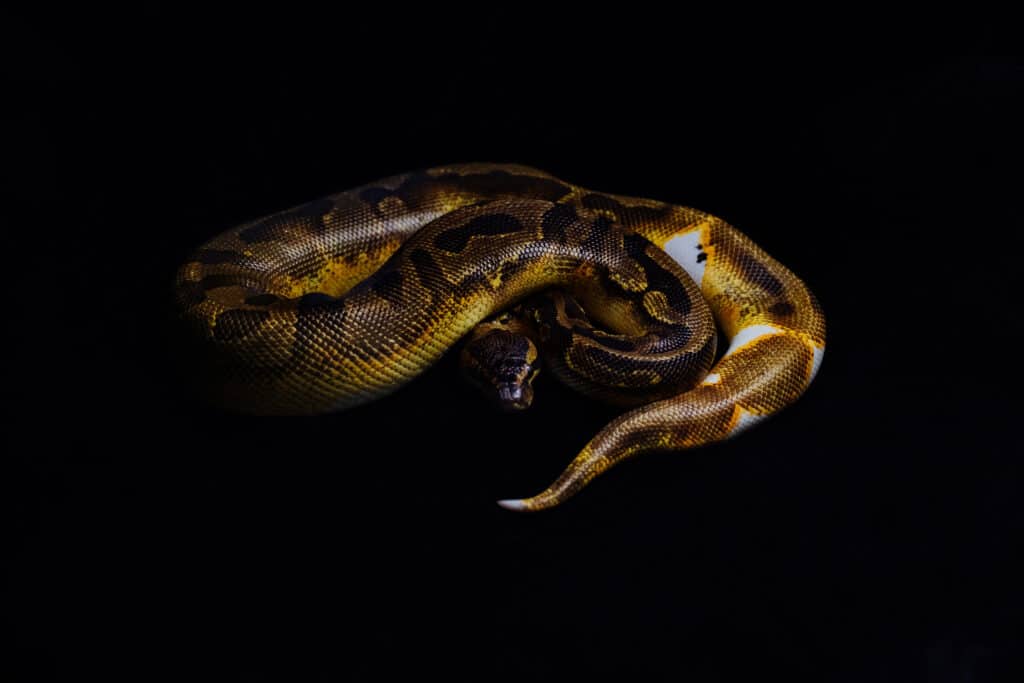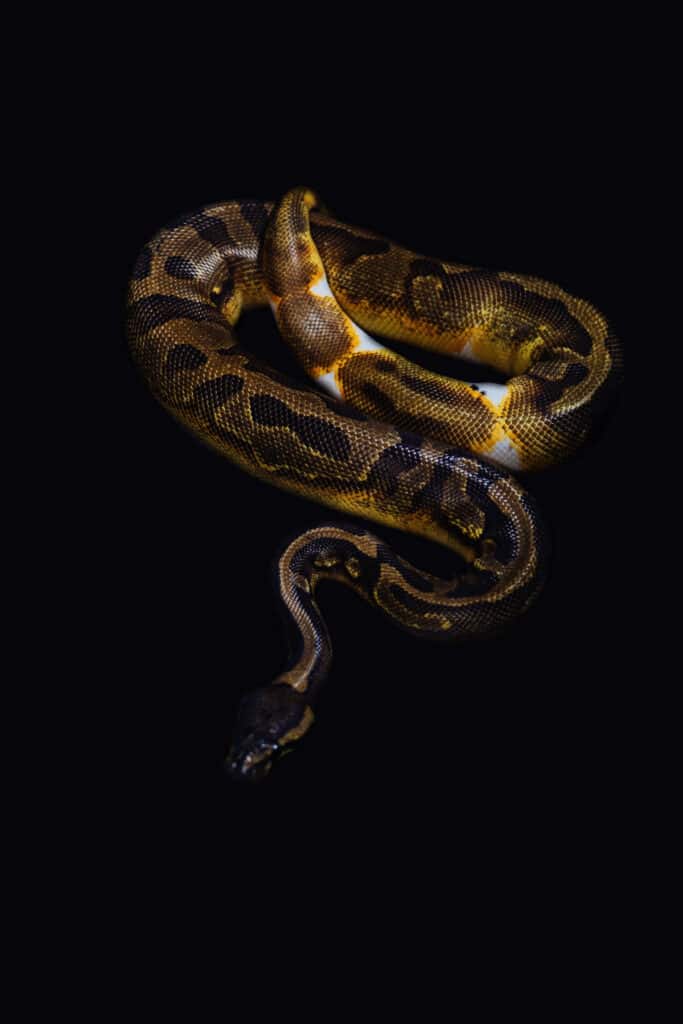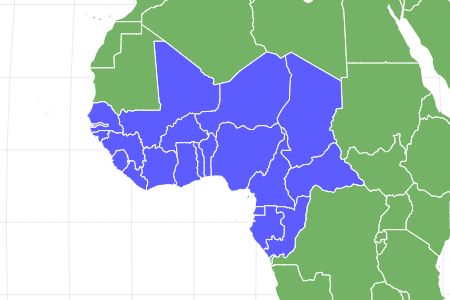Enchi Ball Python
Python regius
Advertisement
Enchi Ball Python Scientific Classification
- Kingdom
- Animalia
- Phylum
- Chordata
- Class
- Reptilia
- Order
- Squamata
- Family
- Pythonidae
- Genus
- Python
- Scientific Name
- Python regius
Read our Complete Guide to Classification of Animals.
Enchi Ball Python Conservation Status
Enchi Ball Python Facts
- Prey
- Rodents, birds, amphibians, fish
- Main Prey
- Small rodents
- Group Behavior
- Solitary
- Most Distinctive Feature
- Increased gold and yellow coloration, high amount of blushing
- Temperament
- Docile, curious, hardy
- Habitat
- Grasslands, savannas, forests
- Diet
- Carnivore
- Lifestyle
- Nocturnal
View all of the Enchi Ball Python images!
“The Enchi ball python morph is notable for its very golden-orange, coppery coloration and high blushing.”
Enchi Ball Python Summary
Out of the more than 4,000 ball python morphs on the market today, the Enchi variety’s background is among the most unique. It was first developed in 2002 by Sweball (based in Sweden) with a breeding pair of ball pythons imported all the way from Ghana!
The Enchi morph is a rather subtle yet stunning color morph with increased orange, yellow, and coppery tones throughout its patterning. Enchi ball pythons also have a high amount of blushing compared to other morphs, particularly around their head and sides of the face. This blushing around the head is often accented by bright yellow or golden eye stripes. Interestingly, their sunny golden coloration only becomes more vibrant with age, with most individuals typically reaching their full color potential at around a year or two.
Notably, Sweball also developed a super version of the morph in 2003 by breeding two Enchi ball pythons together.
3 Amazing Enchi Ball Python Facts!
- The Enchi ball python has an incredibly diverse background compared to many other base morphs. Although the morph was officially developed in Sweden in 2002, the breeding pair used in its development was imported from Ghana in 1998.
- The Enchi morph gets its unique name from Enchi, a town in southwest Ghana. Enchi is the capital of the Aowin Municipality.
- Breeders developed a super version of the Enchi morph in 2003 after Sweball bred two Enchi ball pythons together.
Where to Find Enchi Ball Pythons
The ball python, alternatively called the royal python, is native to western and central Africa, more specifically the Sub-Saharan region. As a rather small yet hardy snake, it fares well in several different habitats. However, it typically resides in grasslands, savannas, and occasionally more densely forested areas.
All ball python morphs belong to the same species, so they share the same general habitat. As a base morph, Enchi ball pythons can technically occur naturally in the wild. Unfortunately, though, wild Enchi snakes are incredibly rare and poorly documented.
Today, the Enchi morph is fairly abundant and well-understood amongst captive reptile breeders. As a result, it is accessible and inexpensive compared to most other ball python color morphs. On average, a typical Enchi ball python costs around $100 to $250. Keep in mind this price will vary potentially significantly depending on who you purchase the snake from, its exact coloration and patterning, and the overall supply and demand of the Enchi morph where you live.
Enchi Ball Python Scientific Name
The ball python’s scientific name, Python regius, means “royal python.” This name comes from the belief that Egyptian royals like Cleopatra would wear live baby serpents–likely ball pythons–on their arms as jewelry. This was likely a means of flaunting power and wealth.
All ball python morphs share the same scientific name because they belong to the same species.
Population & Conservation Status
According to the IUCN Red List, as of 2012, the ball python is near-threatened. Although the species isn’t currently at any substantial risk of going extinct, this could change in the future.
Overall, the ball python’s populations have been decreasing slightly throughout much of its native range in central and western Africa. The main threat to the species is habitat loss due to the agricultural industry. Additionally, the common practices of hunting, eating, and/or selling ball pythons have caused the species’ numbers to decline.
How to Identify Enchi Ball Python: Appearance and Description

Enchi pied ball pythons have increased golden, yellow, orange, and sometimes coppery tones throughout their patterning.
©iStock.com/Li Chun
The Enchi is a fairly subtle base morph that is similar to many other common color morphs at a glance, but it can still be easily identified by a few key traits if you have a keen eye and know what to look for.
In particular, Enchi ball pythons have increased golden, yellow, orange, and sometimes coppery tones throughout their patterning. These bright, sunny markings contrast the snake’s chocolaty brown tones more prominently than the markings of a typical wild-type ball python.
In addition to their warm yellow, orange, and gold markings, Enchi ball pythons have a high amount of blushing compared to other morphs. This simply means Enchi snakes tend to have lots of faded patches mainly along the spine, sides of the body, and head, giving them a soft, blushed appearance.
The Enchi morph’s blushing is usually most apparent around the snake’s head, which will usually have a slightly faded patch between the eyes. This is accented beautifully by the morph’s bold yellow or golden eye stripes.
To sum things up, keep these key traits in mind if you’re trying to identify an Enchi ball python:
- Increased yellow, orange, golden, and coppery tones throughout, contrasting its warm, chocolaty-brown markings
- High amount of blushing, especially atop the head, with bright yellow or golden eye stripes
- Blushing extends throughout the body along the spine and sides
- Yellow and golden tones become much more vibrant with age, making some Enchi snakes challenging to identify until they are one to two years old
Evolution and History
The Enchi morph has one of the most varied backgrounds of any ball python morph today. Although it originated in 2002 in Sweden by Sweball’s Lars Brandell, the breeding pair used in its development hails from Ghana! The morph even gets its name from a town in southwest Ghana, Enchi. Enchi is the capital of Ghana’s Aowin Municipality.
In 1998, Sweball’s breeders received a shipment of juvenile ball pythons with uniquely high amounts of gold and yellow in their patterning. They bred two of the more vibrant and colorful snakes together, resulting in the first documented batch of Enchi ball pythons. By 2003, Sweball also produced a super Enchi variant by breeding two Enchi snakes together.
Today, many reptile breeders have developed their own Enchi lines and variations. Although the Enchi morph is an older, more subtle variety compared to many designer morphs currently on the market, it remains incredibly popular, accessible, and relatively inexpensive worldwide.

Yellow and golden tones become more vibrant with age, making some Enchi snakes challenging to identify until they are one to two years old.
©iStock.com/Li Chun
How Dangerous Are They?
As one of the smallest python species in the world, the ball python is not venomous or especially dangerous to humans. It is a constrictor snake that mainly hunts small rodents, birds, and occasionally amphibians and fish. It does not have fangs. Instead, it has lots of sharp yet small and fragile teeth that angle slightly backward to help the snake better grip its prey.
On top of having no venom and tiny, weak teeth, the ball python is very timid and generally non-aggressive in nature. It actually gets its common name from its habit of tightly coiling its body into a ball when scared or threatened instead of striking or assuming a threatening posture like many other snake species. They very rarely bite, and their bites tend to be very weak and aren’t particularly painful.
If you are bitten by a ball python, first gently and carefully put the snake back into its proper enclosure. Briefly monitor the snake to ensure it has not sustained any injuries. Next, carefully wash the bite wound with soap and warm water. It may be necessary to bandage the wound afterward to help speed up the healing process and prevent the wound from developing an infection. Fortunately, most ball python bites are only mildly painful and don’t require much, if any, treatment.
Behavior and Humans
Because ball pythons are so well-suited to living in captivity, reptile breeders all around the world have developed thousands of unique color and pattern morphs via captive breeding! The Enchi morph is an excellent example of one of these many morphs. Breeders developed it in Sweden in 2002 and it still remains a very popular choice amongst reptile owners today.
In addition to being very docile and gentle around humans, ball pythons are quite curious, active, and intelligent, making them a delight to observe and interact with in captivity. They can thrive in enclosures as small as 50 to 60 gallons and have very straightforward, manageable care requirements. They are generally solitary animals that prefer not to have any tankmates in their enclosures, though they can be quite sociable with humans.
Related Animals
View all 117 animals that start with EEnchi Ball Python FAQs (Frequently Asked Questions)
Are Enchi ball pythons venomous
Like all other members of the Python family, ball pythons are constrictor snakes and entirely non-venomous. They do not have fangs and instead have many small and sharp (yet also fragile) teeth that are angled backward to help them better grip and swallow their prey.
How do Enchi ball pythons hunt?
As fairly small, non-venomous snakes, ball pythons must hunt by simply waiting and ambushing their prey. They wait very quietly, usually while cleverly camouflaged, for a mouse, bird, or perhaps even a frog to come near them, at which point they will quickly strike and grip the prey tightly with their teeth. Next, they rapidly coil their bodies around the prey animal, suffocating it before swallowing it whole!
Fortunately, despite being skilled hunters, they aren’t capable of taking down anything much larger than a rat or a small bird.
Are Enchi ball pythons aggressive?
Ball pythons are generally very timid and non-aggressive toward humans, no matter the particular morph. Their remarkably gentle nature has contributed to their popularity worldwide within the exotic pet trade.
Where do Enchi ball pythons live?
Ball pythons are native to warm, dry regions in Sub-Saharan Africa. They can live in a wide range of habitats, including grasslands, savannas, and forests. As a base morph, Enchi ball pythons can technically exist naturally in the wild, though this is very rare, and actual instances of unique morphs existing in the wild are unfortunately poorly documented.
What do Enchi ball pythons eat?
Ball pythons, regardless of the particular morph, are carnivorous animals that mainly eat small rodents and birds. Occasionally, they will also feed on small amphibians and fish. Since they lack venom and only reach around 5 feet long, ball pythons aren’t much of a threat to larger animals.
How much do Enchi ball pythons cost?
Enchi ball pythons typically cost around $100 to $250. However, this price can vary depending on the breeder you purchase the morph from, the appearance of the snake’s pattern and coloration, and the current supply and demand of the morph in your area. Variations of the morph like the Super Enchi, Pastel Enchi, or Enchi Clown can also be pricier, as they possess multiple traits and require more complicated breeding to reliably produce.
Are Enchi ball pythons rare?
The Enchi morph is fairly common in captivity today and is available for purchase from a wide range of reptile breeders. It was originally developed in 2002, making it among the first base morphs developed and popularized on a large scale. However, many of its variants, like the aforementioned Super Enchi and Enchi Clown, are much rarer because they are designer morphs that are more difficult to breed.
Thank you for reading! Have some feedback for us? Contact the AZ Animals editorial team.
Sources
- Animal Diversity (1970) animaldiversity.org/accounts/Python_regius/
- IUCN Redlist (1970) iucnredlist.org/species/177562/15340592
- Morphpedia (1970) morphmarket.com/morphpedia/ball-pythons/enchi/
- World of Ball Pythons (1970) worldofballpythons.com/morphs/enchi/

















